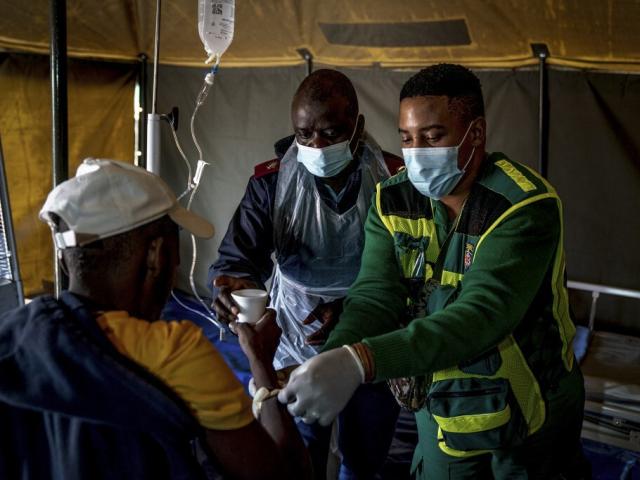In May 2023, the World Health Organization announced that Covid-19 was no longer a “public health emergency of international concern” – its highest level of alert.
The United Nation’s health agency said countries should now be able to manage the virus along with other infectious diseases.
While some may have breathed a sigh of relief, scientists and the UN itself have raised concerns that the sharp focus on Covid-19 since early 2020 may have led to a resurgence of new infections with HIV.
The Joint United Nations Programme on HIV/Aids, or UNAids, the organisation set up to coordinate the global response to HIV/Aids, recorded that 650,000 people died from Aids-related illnesses worldwide in 2021.
In a separate analysis, we highlight that the focus on Covid-19 may have left room for HIV/Aids misinformation to re-emerge or take root. For example, we discuss the resurfacing of the old, widely debunked claim that HIV does not cause Aids, a belief that has had serious consequences for the fight against the spread of HIV.
In this factsheet, we revisit some of the most commonly asked questions about HIV, Aids, treatment and prevention.
Where does HIV come from?
Virologists Françoise Barré-Sinoussi and Luc Montagnier discovered the human immunodeficiency virus (HIV) in 1983.
When one of the first cases of acquired immunodeficiency syndrome (Aids), the life-threatening disease caused by the virus, was reported in France in 1981, Barré-Sinoussi and Montagnier tried to find the virus that caused it. They isolated the virus from the lymph gland of a person with Aids and discovered that a retrovirus, later named HIV, caused Aids.
Similar findings were published in a 1984 study by Robert Gallo, the biomedical researcher who developed the HIV blood test.
Because there was little direct biological data on HIV before the 1980s, the exact origin of the virus is unknown, although one popular theory exists.
By analysing strains of a naturally occurring Aids-like disease caused by the simian immunodeficiency virus (SIV) in nine chimpanzees, this 2006 study found that SIV may have been transmitted from chimpanzees to humans.
Exactly how the virus could have been transmitted from chimpanzees to humans is still unclear.
How is HIV contracted?
The HI virus causes infection when it enters the bloodstream. Once there, it weakens the body’s ability to fight infection by attacking the white blood cells, also called the CD4 or T cells.
These cells are responsible for triggering your immune system to respond to viruses, bacteria, and other germs that can make you sick.
Some of the most common ways that HIV enters the body is through person-to-person contact with body fluids that contain HIV, including blood, semen and vaginal fluids, and breast milk.
Whether or not transmission occurs depends on the viral load of the body fluid. This is the amount of HIV in a person’s body fluids.
Transmission through physical contact with a person with HIV can occur in a number of ways, including:
- Sexual transmission (which includes unprotected vaginal or anal sex)
- Direct contact with blood (which can occur through sharing of needles and syringes)
- Mother-to-child transmission (when a mother with HIV is pregnant and passes the virus on to her baby in the womb or through breastfeeding)
HIV is not spread through casual contact such as kissing, hugging or holding hands.
There is also no evidence that HIV can be transmitted through saliva, tears, sweat, coughing or sneezing.
Who is most at risk of contracting or being exposed to HIV?
Anyone can get HIV.
However, some behaviours have been identified as exposing people to HIV infection. Examples include vaginal or anal sex without a condom and sharing needles with people with HIV whose viral loads are not suppressed.
In this 2023 report, Africa Check cites various studies conducted in the United States which found that pre-existing sexually transmitted infections or diseases (STIs or STDs) often cause sores on the skin, or lesions, that make it easier for HIV to enter the body.
However, interventions such as the HIV pre-exposure prophylaxis (PrEP) and the HIV post-exposure prophylaxis (PEP) have significantly reduced these risks.
PrEP is a pill taken daily by people who do not have HIV, to prevent them from getting the virus. It is also available as an injection.
According to the latest data from UNAids, around 845,000 people in at least 54 countries received PrEP in 2020. Kenya and South Africa accounted for 158,630 or 19% of people who received PrEP at least once that year. Access remains poor in many western and central African countries.
PEP is a pill that is taken if you think you have been exposed to HIV. It must be taken within 72 hours of the possible exposure and for 28 days without interruption.
Other preventative measures include using a condom during sex.
When does HIV become Aids?
HIV infection attacks the body's immune system by “reducing the number of CD4 cells (or T cells) in the body”.
Because these cells are responsible for triggering your immune system to respond to viruses, bacteria, and other germs that can make you sick, if the virus is left untreated it will lead to immune failure or immunodeficiency in a person with HIV.
This state of immune failure is one of the most advanced stages of the HIV infection and is known as Aids.
Not all people with HIV necessarily have or develop Aids.
A person with HIV is considered to have progressed to Aids when their CD4 cell count falls below 200 cells per cubic millimetre of blood or per drop of blood. The count of a well-functioning immune system is 500 to 1500 cells per drop of blood.
Although the time between becoming infected with HIV and developing Aids varies from person to person, the majority of people living with HIV who are untreated will develop symptoms of Aids within eight to 10 years.
Is there a cure for HIV?
HIV is treatable and manageable, but there is currently no cure.
Through a process called viral suppression, people with the virus can reduce the viral load in their bodies, making HIV undetectable and making it less likely that they will pass it on to others.
According to the National Institute of Allergy and Infectious Diseases, an agency of the US department of health, “when a person living with HIV begins an antiretroviral treatment regimen, their viral load drops”.
“For almost everyone who starts taking their HIV medication daily as prescribed, viral load will drop to an undetectable level in six months or less.”
How do antiretroviral drugs work?
Antiretroviral medicines (ARVs) are used to treat HIV.
These drugs keep the amount of virus in the body low by stopping HIV from making copies of itself at different stages of the virus’s life cycle.
There are different types of ARVs and each type attacks HIV differently. HIV treatment usually involves a combination of different types.
Although ARVs are not a cure for HIV or Aids, they improve the quality of life for people living with the virus.
How do HIV tests work? Are they reliable?
HIV testing is the process of finding out a person’s HIV status.
This can be done in a number of ways, including from a blood sample, usually taken from a finger prick or a person’s vein, and from saliva.
The tests look for:
- Antibodies to HIV, which are special disease-fighting cells that the body produces when it first detects an HIV infection. They usually become detectable in most people within three months of contracting the virus.
- The p24 antigen, which is a protein part of the outer layer of HIV. Antigen tests can usually detect it within 18 days of exposure.
- Viral load, by a nucleic acid test which can usually detect HIV from 10 days of exposure.
HIV self-testing kits are available. They use saliva to check for antibodies to HIV.
However, the US Food and Drug Administration has advised that the results from self-testing kits should be considered “as a first step in HIV testing” and should be followed up with testing by a healthcare professional.








Add new comment